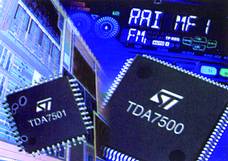

Thermionic valves were very rapidly made obsolete by transistors because transistors offered price/performance advantages even when they were at the beginning of their evolution and valves were at the end of theirs. The battle between analog and digital has been going on for much longer because the digital algorithms required to perform analog functions sometimes demand processing power that is not currently available at an acceptable cost.
However, it is a fact of life in the microelectronics industry that if the digital price/performance you need is not available today, it will be soon - next week, next month, next year.
The consequences can be seen in every field of application, from cordless telephones to industrial controllers. Even hearing aids for the deaf which were once simple analog audio amplifiers, now contain digital circuitry and nonvolatile memory so that the gain/frequency profile can be accurately matched to the user's ear function.
Radically new
One of the most recent beneficiaries of the digitalisation trend is the car radio. Although ST has a distinguished history as a supplier of analog car radio chips and currently supplies around 20% of the $1 billion a year world market, its most recent product introduction in this area is entirely digital, apart from the input and output data converters.
Known as the TDA-7500, the device integrates two 24-bit digital signal processor (DSP) cores, four 20-bit ADCs, three 20-bit DACs, as well as glue logic and interfaces. Using only digital processing, the TDA7500 performs all of the FM, AM and stereo decoding functions (no LC-resonators to tune), plus all of the volume, balance, fader, loudness and tone controls. It can also implement, depending only on the stored program, a wide range of audio processing functions such as equalisation, reverberation, 3D sound enhancement, Dolby processing and music search.
Why digital now?
The main advantage of a programmable digital solution is that it allows car radio manufacturers to add new features simply by changing the software. Like equipment manufacturers in many other areas, car radio makers need to bring differentiated products to the market in the shortest possible time and at the lowest possible cost. The cost constraints make system-on-chip solutions mandatory but if the system were entirely defined by the chip hardware, product differentiation would be hard to achieve. With a programmable solution, the same hardware platform can be used for a whole range of radio products, offering a wide variety of capabilities at different prices. The time taken to develop a new model - in response, for example, to a new product launched by a competitor - is largely determined by the time it takes to write and debug new software modules or even just to include features such as 3D sound enhancement or text-to-speech conversion (for translating encoded traffic bulletins) that are already available in ST's standard DSP software library.
Major equipment makers in Japan and Europe have already designed in the TDA7500 and the first models based on the chip will be on the market in mid-2000, although it could take another three or four years before digital processing replaces analog in the majority of car radios.
The area where the digital solution is most attractive immediately is the high end of the market where the car radio is evolving into the heart of a new kind of car information and entertainment centre. Although this evolution is inevitable, it is still in its early stages but the first real applications have already started to appear.
"Keep your eyes on the road and your hands upon the wheel ..."
Visitors to the Italian lake district may be familiar with the Telepass automatic toll payment system, developed by ST and Società Autostrade, the company that manages most of Italy's motorways.
The latest system known as Mentor, was developed in conjunction with ST and a leading European communications company. It transforms the existing automatic toll payment system into a full information and traffic management system that provides, among other things, fast and efficient response to road accidents.
This new development was made possible by integrating technology from ST and the communications partner into a digital data interchange module mounted on the front of participating vehicles. The module includes GSM and GPS (global positioning by satellite) functions and is also connected to various sensors, such as the crash sensor and could be linked to anti-thief detectors in the vehicle. It also includes ST's Euterpe voice processor which converts traffic information in the form of GSM 'short messages' received from Società Autostrade's web site into voice messages for the driver, as well as allowing voice activation of the mobile telephone so that drivers can literally keep their eyes on the road and their hands upon the wheel!
For individual drivers, the new system offers the assurance of immediate assistance in the case of accidents or emergencies. Once a vehicle has entered the motorway system covered by the motorway system covered by Mentor, the combination of GSM and GPS technologies ensure that its position is continually monitored. Requests for assistance, either issued manually by pressing a button on the Mentor unit or triggered automatically - for example, by activation of the airbag - generate an immediate response, without the need for someone to walk to the nearest available emergency telephone.

© Technews Publishing (Pty) Ltd | All Rights Reserved